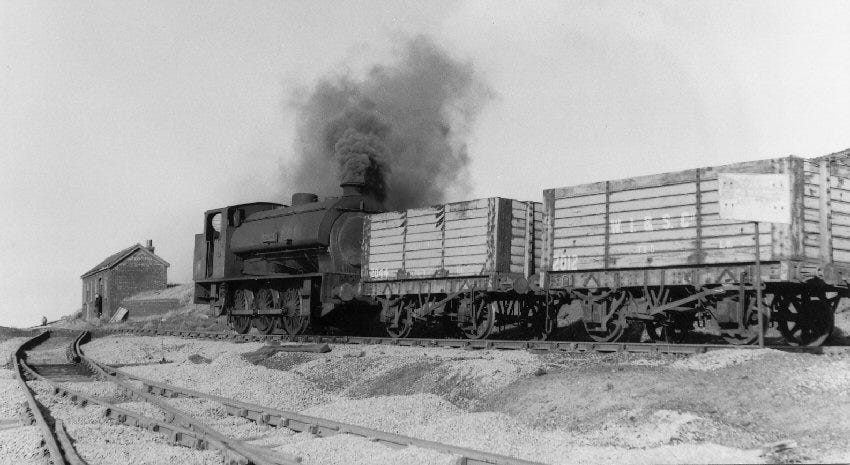The Forgotten Iron Rush: Lower Island Cove’s Mysterious Mining Past
Let’s take a moment to talk about something that most people have never heard of—something buried deep in the history of Lower Island Cove. It’s not a ghost story, though some might argue it should be. It’s not a legendary treasure hunt, but for a while, people sure thought it was. No, this is about a mine. The Mine.
If you ask around Lower Island Cove about The Mines, you’ll likely hear childhood stories of berry picking, bonfires, and parties in the woods. Maybe someone will mention the old quarries, or even the abandoned garbage dump. But what many people don’t realize is that the land they grew up exploring once held a dream of wealth—a dream that crumbled as quickly as it started.
This is the story of the Workington Mine, also known as the Bay de Verde Mine, or more formally, the Newfoundland Iron Ore Company Mine. It’s a story of big promises, bigger failures, and a whole lot of red dirt.
The Beginning: A Discovery That Almost Changed Everything
Back in the late 1800s, Newfoundland was no stranger to iron mining. Bell Island was already making waves in the industry, and prospectors were eager to find the next big deposit. Enter Andrew Colford, a man who, in 1885, stumbled upon iron ore in Lower Island Cove.
At first, newspapers reported that the mine was in Northern Bay (oops), but the real discovery was at Bluff Head—a well-known fishing spot in the area. Now, Colford was a prospector, not a businessman. He needed funding, so he reached out to a wealthy St. John’s jeweler, Robert Sleater.
Sleater had money. And money meant power. He quickly assembled a team, staked 14 claims, and promised Colford a share of the profits. But here’s the catch: Colford, like many hopeful prospectors, found himself drowning in debts. By 1896, he had lost his entire share of the mine just to pay his grocery bills. His name would fade into the background, while bigger players moved in.
The Railway to Nowhere
By 1898, things were looking serious. The H. Spencer and Company of Workington, England, had taken an interest in the mine, sending engineers to evaluate its potential. The company quickly realized there was a problem—Lower Island Cove didn’t have a suitable location for a shipping pier.
The solution? Build a railway.
In a massive effort, 150 men constructed a railway from the mine to Old Perlican, where a large pier was built to ship the iron ore. The railway itself was a marvel—complete with a bridge over Pissingmare Brook (yes, that’s its real name). But like so many things in this story, the excitement didn’t last.
The railway operated from 1898 to 1901, and today, all that remains is an overgrown path. Once a lifeline of industry, it’s now just another ATV trail swallowed by the trees.
The Mine That Didn’t Want to Be Mined
On paper, the Workington Mine had everything—a railway, a pier, expensive equipment, and a workforce ready to go. But there was one problem: the mine itself.
Seven shafts were dug, and each one led to disappointment. The iron ore deposits were smaller than expected. The shafts flooded constantly. And the deeper they dug, the worse the results got.
Still, they kept trying. Boilers, crushers, machine shops, even luxurious houses for managers were built around Pissingmare Pond. Today, almost nothing remains. A few concrete foundations peek through the trees, and if you dig around, you might still find chunks of iron ore buried in the red-stained soil.
The Explosion That Stopped Everything
As if things weren’t bad enough, tragedy struck on May 26, 1899.
Eight men were working in Shaft #1 when two of them, R. Barrett and M. Colford, unknowingly drilled into an unexploded charge of dynamite. The resulting blast was catastrophic.
Barrett suffered severe injuries, requiring amputation of his limbs. Colford and a third man, Thorne, were also wounded. The newspapers feared at least one of them wouldn’t survive. In later reports, it was said that Barrett, a man from Holyrood, later died from his injuries.
Mining operations came to a screeching halt.
The Newfoundland Iron Ore Company tried to salvage what they could, managing to send one shipment of iron to England. But by the fall of 1899, they had given up.
Keep reading with a 7-day free trial
Subscribe to The Newfoundland History Sleuth to keep reading this post and get 7 days of free access to the full post archives.




